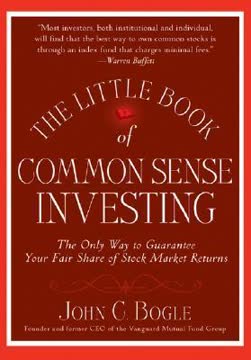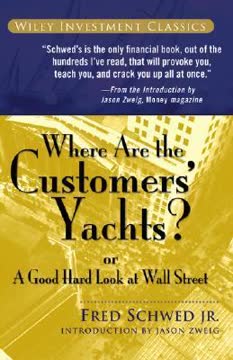Key Takeaways
1. The Unpredictability of Markets: A Lesson in Humility
"Speculation is an effort, probably unsuccessful, to turn a little money into a lot."
Markets are inherently unpredictable. Despite the claims of many financial "experts," no one can consistently predict short-term market movements or pick winning stocks with certainty. This unpredictability stems from the complex interplay of countless factors, including:
- Economic conditions
- Political events
- Technological advancements
- Company-specific news
- Investor psychology
The stock market is not governed by physical laws like gravity, but by the collective actions and emotions of millions of participants. This makes it impossible to forecast with precision, and humility is essential for any investor.
2. The Fallacy of Professional Stock-Picking
"Thus far in our history there has been little evidence that there exists a demonstrable skill in managing security portfolios."
Professional fund managers often underperform. Despite their education, resources, and claimed expertise, most professional fund managers fail to consistently outperform the market average over extended periods. This counterintuitive reality is supported by numerous studies and can be attributed to several factors:
- High fees eating into returns
- Overconfidence leading to excessive trading
- The efficient market hypothesis (information is quickly priced into stocks)
- Regression to the mean (top performers tend to revert to average over time)
This doesn't mean professional managers are incompetent, but rather that beating the market consistently is extraordinarily difficult. For most investors, low-cost index funds that track broad market indices may be a more effective strategy.
3. The Dangers of Speculation and Short-Term Thinking
"The habit of buying popular shares works for bad results … It must tend to get the buyer in nearer the top than the middle."
Short-term speculation is often a losing game. Many investors fall into the trap of trying to make quick profits by jumping in and out of stocks based on short-term price movements or popular trends. This approach is fraught with risks:
- Higher transaction costs eating into returns
- Increased likelihood of buying high and selling low
- Missing out on long-term growth and compounding
- Emotional decision-making leading to poor choices
Instead of chasing hot stocks or trying to time the market, investors are better served by focusing on long-term value and developing a disciplined investment strategy.
4. The Power of Long-Term, Patient Investing
"The most powerful force in the universe is compound interest."
Time is the investor's greatest ally. The magic of compound interest means that patient, long-term investors can potentially achieve significant wealth accumulation over time, even with modest returns. This approach offers several advantages:
- Reduced impact of short-term market volatility
- Lower transaction costs and taxes
- Ability to benefit from the long-term growth of successful companies
- Emotional detachment from day-to-day market movements
To harness the power of compounding:
- Start investing early
- Reinvest dividends and capital gains
- Stay invested through market ups and downs
- Focus on quality companies or broad market indices
5. The Importance of Understanding Risk and Diversification
"Wide diversification is only required when investors do not understand what they are doing."
Risk management is crucial for successful investing. While taking calculated risks is necessary for potential returns, understanding and managing risk is essential to avoid catastrophic losses. Key concepts include:
- Diversification: Spreading investments across different asset classes, sectors, and geographies
- Asset allocation: Balancing higher-risk assets (e.g., stocks) with lower-risk assets (e.g., bonds)
- Risk tolerance: Aligning investment strategy with personal financial goals and comfort level
However, as Warren Buffett suggests, excessive diversification can dilute returns. The key is to find a balance between risk management and focused investing based on thorough research and understanding.
6. The Pitfalls of Financial Industry Practices and Earnings Management
"Earnings can be pliable as putty when a charlatan heads the company reporting them."
Be wary of financial industry practices and corporate accounting tricks. The financial services industry and corporate executives sometimes engage in practices that may not serve investors' best interests:
Financial industry pitfalls:
- Encouraging excessive trading ("churning")
- Selling complex, high-fee products
- Providing overly optimistic forecasts
Corporate accounting tricks:
- Earnings management to meet analyst expectations
- Creative accounting to hide liabilities or inflate assets
- Non-GAAP metrics that paint an overly rosy picture
Investors must approach financial statements and industry recommendations with a critical eye, always questioning the motivations behind the information presented.
7. The Value of Fundamental Analysis and Rational Decision-Making
"(An investor) should be able to justify every purchase he makes and each price he pays by impersonal, objective reasoning."
Rational analysis is key to successful investing. While markets can be emotional and unpredictable in the short term, long-term success is more likely to come from a disciplined approach based on fundamental analysis. This involves:
- Studying financial statements to understand a company's true financial health
- Assessing the competitive landscape and industry trends
- Evaluating management quality and corporate governance
- Determining a fair value for the stock based on various metrics (e.g., P/E ratio, discounted cash flow)
By focusing on objective data and rational decision-making, investors can avoid many of the pitfalls associated with emotional or trend-based investing.
8. The Impact of Human Behavior on Investment Decisions
"Blinded by greed and wishful thinking we often seem to believe that huge and growing market momentum is a strong signal that a pattern will continue. In fact, such momentum often creates the very conditions that produce a painful correction."
Understanding behavioral finance is crucial. Human psychology plays a significant role in investment decisions, often leading to irrational behavior and market inefficiencies. Common behavioral biases include:
- Overconfidence: Overestimating one's ability to pick winners
- Herd mentality: Following the crowd into popular investments
- Loss aversion: Holding onto losing investments too long
- Recency bias: Giving too much weight to recent events
By recognizing these biases in ourselves and others, investors can make more rational decisions and potentially capitalize on market inefficiencies created by others' irrational behavior.
Last updated:
FAQ
What is "Fred Schwed's Where are the Customers' Yachts? A modern-day interpretation of an investment classic" by Leo Gough about?
- Satirical look at investing: The book is a modern interpretation of Fred Schwed’s 1940 classic, using humor and wit to expose the realities and follies of the financial industry.
- Focus on investor psychology: It explores the psychology of both investment professionals and their customers, highlighting how little has changed in market behavior over decades.
- Critique of financial advice: The book questions the value of advice provided by the financial services industry, suggesting that much of it is of little real use to investors.
- Timeless lessons: Through anecdotes and analysis, it draws parallels between past and present financial crises, showing that human nature and market mistakes are perennial.
Why should I read "Where are the Customers' Yachts?" by Leo Gough?
- Understand market realities: The book demystifies the stock market, revealing the truth behind common investment myths and industry practices.
- Learn from history: By connecting past booms, busts, and scandals to modern events, it helps readers avoid repeating old mistakes.
- Accessible and entertaining: The use of humor and real-world examples makes complex financial concepts easy to grasp for both beginners and experienced investors.
- Practical wisdom: It offers actionable advice on topics like risk, diversification, speculation, and long-term investing, making it valuable for anyone managing their own money.
What are the key takeaways from "Where are the Customers' Yachts?" by Leo Gough?
- Skepticism about expertise: Most professional fund managers and stock-pickers do not consistently outperform the market, and their expertise is often overstated.
- Long-term focus wins: Investing for the long haul, rather than chasing quick profits or market timing, is the most reliable way to build wealth.
- Risk and diversification: Understanding and managing risk, rather than seeking high returns, is crucial; diversification is important but has its limits.
- Human nature drives markets: Investor psychology, herd behavior, and susceptibility to fads and stories often lead to poor decisions and market bubbles.
What is the meaning behind the title "Where are the Customers' Yachts?" and how does it reflect the book's message?
- Origin of the title: The title comes from an old joke where a tourist, seeing bankers’ and brokers’ yachts, asks where the customers’ yachts are—implying customers rarely get rich from financial markets.
- Industry profits over customer gains: It highlights that financial professionals often profit more from fees and commissions than their clients do from investments.
- Cautionary message: The title serves as a warning to investors not to blindly trust the financial industry’s promises of wealth.
- Central theme: It encapsulates the book’s skepticism about the value of most financial advice and the difficulty of beating the market.
How does "Where are the Customers' Yachts?" by Leo Gough define and differentiate between investment and speculation?
- Investment vs. speculation: Investment is described as the effort to prevent a lot of money from becoming a little, while speculation is the (often unsuccessful) attempt to turn a little money into a lot.
- Blurred lines: The book notes that the distinction is not always clear, as even "safe" investments can turn out to be speculative in hindsight.
- Human psychology: Speculation is driven by excitement and overconfidence, especially during market booms, while true investors focus on long-term preservation and growth.
- Advice to readers: Beginners are cautioned against speculation, as the odds are stacked against consistently picking winners.
What does "Where are the Customers' Yachts?" by Leo Gough say about professional stock-picking and fund management?
- No consistent outperformance: The book argues that, as a group, professional fund managers do not consistently beat the market averages over time.
- Skill vs. luck: While some managers may outperform for a period, this is often due to chance rather than skill, and few can maintain superior performance.
- Index funds as an alternative: The book suggests that most investors would be better off in low-cost tracker or index funds rather than paying for active management.
- Critical of industry hype: It exposes how the financial industry markets the illusion of expertise to justify high fees.
What are the main lessons about risk, diversification, and market cycles in "Where are the Customers' Yachts?" by Leo Gough?
- Risk is unavoidable: There is no such thing as a risk-free investment; even "safe" assets can lose value due to inflation or unforeseen events.
- Diversification has limits: While spreading investments reduces risk, over-diversification can dilute returns and is not a substitute for understanding what you own.
- Market cycles are inevitable: Booms and busts are a natural part of economic life; investors should not assume good times will last forever.
- Avoiding big mistakes: The book emphasizes the importance of not increasing risk to chase higher returns and being wary of popular investments during booms.
How does "Where are the Customers' Yachts?" by Leo Gough address the role of human behavior and psychology in investing?
- Behavioral finance insights: The book discusses how investors are influenced by emotions, herd mentality, and overreaction to news, leading to poor decisions.
- Regression to the mean: It explains that exceptional performance is often followed by average or poor results, cautioning against chasing recent winners.
- Loss aversion: People tend to overreact to losses and dramatic events, which can result in selling at the worst possible times.
- Patience and discipline: Successful investing requires resisting impulses and sticking to a long-term plan, rather than reacting emotionally to market swings.
What practical investment strategies and advice does "Where are the Customers' Yachts?" by Leo Gough recommend?
- Live off income, not capital: The book advises against spending investment capital and instead recommends living off the income generated by investments.
- Invest for the long term: It promotes patient, long-term investing, taking advantage of compound interest and market growth over time.
- Minimize costs and churn: Frequent trading and high transaction costs erode returns; investors should keep trading to a minimum.
- Be cautious with new trends: Avoid getting swept up in popular fads, hot stocks, or new issues without thorough research.
How does "Where are the Customers' Yachts?" by Leo Gough explain key financial concepts like probability, discounted cash flow, and valuation ratios?
- Probability and randomness: The book stresses the importance of understanding probability, as short-term price movements are often random and unpredictable.
- Discounted cash flow (DCF): DCF is presented as a method to value companies based on the present value of future cash flows, though it relies on assumptions.
- Valuation ratios: Ratios like price/earnings (P/E), price/book, and price/sales are explained as tools for comparing companies, but should be used with industry context.
- Limits of precision: All these methods provide estimates, not certainties, and should be used as part of a broader analysis.
What are some of the best quotes from "Where are the Customers' Yachts?" by Leo Gough and what do they mean?
- "Speculation is an effort, probably unsuccessful, to turn a little money into a lot." – Highlights the dangers and low odds of speculative investing.
- "A man’s true wealth is his income, not his bank balance." – Emphasizes the importance of sustainable income over flashy net worth.
- "Wide diversification is only required when investors do not understand what they are doing." (Warren Buffett) – Suggests that knowledge can sometimes substitute for broad diversification.
- "Time is your friend; impulse is your enemy." (John Bogle) – Advocates for long-term, patient investing over emotional, short-term decisions.
- "The most powerful force in the universe is compound interest." (Albert Einstein) – Underlines the exponential benefits of long-term investing and reinvestment.
How does "Where are the Customers' Yachts?" by Leo Gough critique the financial industry and its professionals?
- Questionable value of advice: The book argues that much of the financial industry’s advice is self-serving and does not reliably benefit customers.
- Conflicts of interest: It exposes how professionals profit from fees, commissions, and frequent trading, often at the expense of clients.
- Prevalence of questionable practices: While outright fraud is rare, misleading marketing, churning, and performance manipulation are common.
- Skepticism toward credentials: Simply working in finance or being wealthy does not make someone a good investor; many professionals lack real investment skill.
What is the "fat, stupid peasant" approach in "Where are the Customers' Yachts?" by Leo Gough, and why is it recommended?
- Long-term, passive investing: The "fat, stupid peasant" approach refers to buying good investments and holding them patiently, rather than constantly trading.
- Benefits of compounding: By sitting on investments and reinvesting dividends, investors benefit from the power of compound interest over time.
- Avoiding costly mistakes: This approach minimizes transaction costs, emotional errors, and the temptation to chase fads or time the market.
- Simplicity and effectiveness: While not glamorous, this method is presented as one of the most reliable ways to build wealth for ordinary investors.
Review Summary
"Where Are the Customers' Yachts?" receives mixed reviews, with an average rating of 3.6/5. Some readers praise it as a condensed version of financial wisdom, offering useful advice for beginners. Others find it too basic or outdated. The book is appreciated for its humor and timeless insights into Wall Street, though some prefer the original version. Readers value its lessons on investment principles, diversification, and long-term planning. Critics note that certain information may be oversimplified or misleading, particularly regarding technical analysis and derivatives.
Similar Books










Download PDF
Download EPUB
.epub digital book format is ideal for reading ebooks on phones, tablets, and e-readers.




